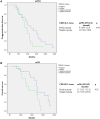A preliminary study on the prognostic significance of cysteine-rich EGF ligand domain 2 protein (CRELD2) in patients with triple negative breast cancer
- PMID: 39869369
- PMCID: PMC12097403
- DOI: 10.17305/bb.2024.11865
A preliminary study on the prognostic significance of cysteine-rich EGF ligand domain 2 protein (CRELD2) in patients with triple negative breast cancer
Abstract
The cysteine-rich epidermal growth factor ligand domain 2 protein (CRELD2) is associated with pathways that regulate epithelial-to-mesenchymal transition, a critical process driving cancer metastasis. This study aimed to determine the prognostic value of CRELD2 status on survival outcomes in triple-negative breast cancer (TNBC). Seventy patients were included in the study. Thirty-four patients were metastatic, and 36 patients were non-metastatic. CRELD2 protein expression in tumor tissue was determined by immunohistochemical staining (IHC). The patients were divided into two groups: CRELD2 positive and negative groups. Clinicopathological features and survival outcomes were compared between the groups. In the survival analysis of the non-metastatic patient group, five-year overall survival (OS) rate was 91.7% in the CRELD2-positive patient group and 91% in the negative group (P = 0.91). Median progression free survival (PFS) was 9.4 (95% confidence interval [CI]: 6.4-12.4) months in the CRELD2-positive group and 11.9 (95% CI: 8.2-18.6) months in the CRELD2-negative group (P = 0.04). The median OS was 17.2 (95% CI: 13.7-22.3) months in the CRELD2-positive group and 24.7 (95% CI: 21.8-29.6) months in the CRELD2-negative group (P = 0.02). In multivariate analysis, CRELD2 status (negative vs positive) (hazard ratio [HR]: 0.50, 95% CI: 0.38-0.96, P = 0.02) was determined to be a risk factor for OS and CRELD2 status (negative vs positive) (HR: 0.82, 95% CI: 0.33-0.96, P = 0.01) was defined as a risk factor for PFS in patients with metastatic TNBC. This is the first clinical study to determine the effect of CRELD2 on survival and as a prognostic marker in patients with triple metastatic breast cancer. These results need to be validated prospectively with a large sample size.
Conflict of interest statement
Conflicts of interest: Authors declare no conflicts of interest.
Figures


References
-
- Helenius A, Marquardt T, Braakman I. The endoplasmic reticulum as a protein-folding compartment. Trends Cell Biol. 1992;2:227–31. https://doi.org/10.1016/0962-8924(92)90309-B. - PubMed
-
- Kim I, Xu W, Reed JC. Cell death and endoplasmic reticulum stress: disease relevance and therapeutic opportunities. Nat Rev Drug Discov. 2008;7:1013–30. https://doi.org/10.1038/nrd2755. - PubMed
-
- Okada T, Yoshida H, Akazawa R, Negıshı M, Mori K. Distinct roles of activating transcription factor 6 (ATF6) and double-stranded RNA-activated protein kinase-like endoplasmic reticulum kinase (PERK) in transcription during the mammalian unfolded protein response. Biochem J. 2002;366:585–94. https://doi.org/10.1042/bj20020391. - PMC - PubMed
-
- Yoshida H, Matsui T, Yamamoto A, Okada T, Mori K. XBP1 mRNA is induced by ATF6 and spliced by IRE1 in response to ER stress to produce a highly active transcription factor. Cell. 2001;107:881–91. https://doi.org/10.1016/s0092-8674(01)00611-0. - PubMed
-
- Oh-hashi K, Koga H, Ikeda S, Shimata K, Hirata Y, Kiuchi K. CRELD2 is a novel endoplasmic reticulum stress-inducible gene. Biochem Biophys Res Commun. 2009;387:504–10. https://doi.org/10.1016/j.bbrc.2009.07.047. - PubMed

